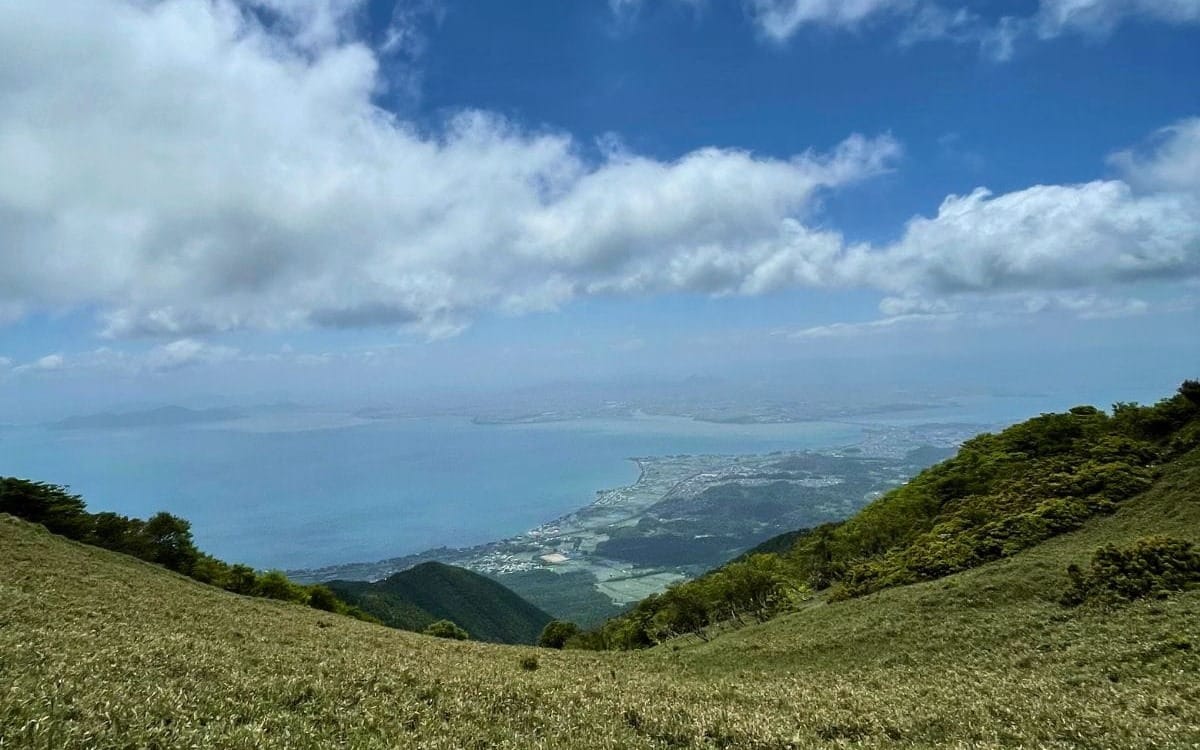Best Seasons for Hiking in Kyoto🗓️
Each season in Kyoto has its own charm—and its own challenges. Here’s a breakdown to help you plan your hike:

Spring (March to May)🌸 🌿
•Cherry blossoms in late March to early April
•Fresh green leaves in April and May
•Cool mornings and pleasant temperatures
•Trails can be busy during hanami (flower-viewing) season
This is one of the best times to hike. The air is clear, and nature is waking up. I like going early in the morning when the birds are most active.

Summer (June to August)☀️
•Hot and humid, especially in the city
•Forest hikes and river trails offer cooler air
•Be careful of heatstroke—bring water and take breaks
•Best to start early as possible (before 8 am)
In the peak of summer, I avoid long, exposed trails. But shaded paths along rivers can still be enjoyable.
Also, keep in mind: Japan is not just hot—it’s humid. The humidity is so high that your sweat doesn’t evaporate easily. This means your body can’t cool down well, and it feels even hotter than the actual temperature.
If you plan to hike for a full day, each adult should carry at least 2 liters of water. I usually bring one bottle in my hand and keep another frozen in my bag. Drinking small amounts often is better than waiting until you feel thirsty.

Rainy Season (梅雨, Tsuyu – mid-June to mid-July)🌧️
•Frequent rain, high humidity
•Trails may be slippery, muddy, or even flooded
•Mountain leeches (山ビル, yamabiru) become active
•Bring a light rain jacket and waterproof shoes
This season can be peaceful if you enjoy misty, quiet trails—but always check the forecast. Sudden heavy rain (Guerilla gouu) can cause flash floods on narrow mountain paths. I usually choose low-risk trails or take this time to rest and plan my next hike.
Tip: Don’t underestimate rainy days. If the trail is slippery, it’s okay to turn back. Safety first!
Autumn (September to November)🍁
•Colorful foliage in late October and November
•Comfortable temperatures and clear skies
•Busy weekends in famous areas like Arashiyama or Kurama
This is my favorite season for hiking. The air is crisp, and even familiar trails feel new with the changing colors. I recommend weekday hikes if you want to avoid crowds.

Winter (December to February)❄️
•Quiet, peaceful trails—sometimes with snow
•Some high mountains (like Mt. Hiei, Mt. Atago) can be icy
•Short daylight hours—start early and finish by 3–4 pm
•Bring warm layers, gloves, and maybe microspikes
Snow hikes can be magical. The silence of a snowy forest, the crunch of ice under your boots, the way temples look with a dusting of white—it feels like walking through a dream.
But also, winter hikes require more strength and skill than in other seasons. Snow and ice make the trails harder to walk, and your body uses more energy just to stay warm. Even familiar paths can feel completely different when covered in snow.
If you’re unsure or not confident, it’s totally okay to skip snow hikes.
There’s no shame in choosing safety. Try a lower trail or wait for spring.
I personally love winter hiking, but I always check the weather, pack extra gear, and hike with friends. The mountains will still be there next time.

⚠️ Dangerous (or Just Unpleasant) Wildlife
Japan’s mountains are usually safe, but hikers should be aware of some animals and insects—especially in warmer seasons. Here are the main ones you may encounter in Kyoto’s forests:
🦟 Mosquitoes – The Most Common (and Most Annoying) One
•Most active from May to October, especially during the summer
•They like shady, humid areas—riversides, dense forest, tall grass, and still air
•Bites are more common during early morning and evening, when it’s cooler
Among all the bugs in Kyoto’s mountains, mosquitoes are the most common—and honestly, the most annoying. They don’t hurt, but the itchy bumps can last for days and really ruin the mood of a peaceful hike.
How to protect yourself:
•Wear long sleeves and long pants, even in summer
•Apply bug spray to exposed skin (don’t forget ankles and neck!)
•Keep moving—mosquitoes love it when you stop for a rest
I once made the mistake of resting near a quiet stream in July without bug spray. Ten bites around my ankles—and a week of regret. Lesson learned—never skip the spray!
💡 Tip: In Japan, we have something you might not often see overseas—anti-itch creams specifically for mosquito bites.
You can find them in any drugstore. Two popular brands are Muhi and Kinkan. They work surprisingly well, so if you do get bitten, give them a try!
🩸 Yamabiru (山ビル) – Mountain leeches
•Active from June to October, especially after rain
•They live in wet leaf piles and grass
•Not dangerous, but annoying—they latch onto your skin and suck blood
•You might not feel them at first, and they can leave small wounds
How to protect yourself:
•Use bug repellent (especially with DEET) on shoes and legs
•Wear long socks and tuck pants into them
•Carry salt—sprinkling salt makes them fall off
•Don’t pull them with fingers (can cause skin trouble)
I got bit once during a rainy summer hike in Mt.Hiei. I didn’t feel anything until I saw blood soaking into my sock—kind of a horror movie moment! Since then, I always keep a small salt packet in my bag.
🐝 Suzumebachi (スズメバチ) – Giant hornets
•Seen from late summer to early autumn
•Very large and loud, with orange-black coloring
•Can be aggressive if you get too close to their nest
•Multiple stings can be dangerous
Among all mountain insects in Japan, giant hornets are the most feared—and for good reason. They defend their nests fiercely and their stings can be painful or even dangerous.
⚠️ Be especially careful around late September, when their colonies are largest and most aggressive. This is their peak season—many nests are full of new queens, and the workers become very defensive.
How to avoid them:
•Wear neutral-colored clothes (avoid black, red, or bright colors)
•Don’t wear strong perfumes or scented lotions
•If one flies near you, stay calm and slowly walk away—don’t swat at it
If you get stung and experience dizziness, swelling, or trouble breathing, seek medical help immediately. But in most cases, hornets will ignore you if you stay respectful and keep your distance.
🐍 Mamushi (マムシ) – Japanese pit viper
•Found in fields, low mountain trails, or near water
•Short, thick snake with a triangle-shaped head and dark coin-like patterns
•Rarely seen, and not aggressive unless surprised
Mamushi is one of Japan’s few venomous snakes. They are active from April to October, especially in warm months. They tend to stay still in tall grass or near streams, waiting to catch small animals.
Most hikers will never see one—but it’s good to know they’re out there.
Safety tips:
•Watch where you step, especially in grassy or rocky areas
•Don’t put your hands in holes or under rocks
•If you see a snake, don’t panic—just give it space
•Do not try to kill it—snakes are part of the ecosystem and will usually leave you alone
Important note: Most other snakes in Japan are non-venomous or mildly venomous. Mamushi is the only one in Kyoto you need to be truly cautious of.
If bitten:
•Stay calm and seek immediate medical help
•Try not to move the bitten limb too much
•If possible, take a photo of the snake from a safe distance—this can help doctors identify the species
According to recent safety advice in Japan, taking a picture is safer and more helpful than trying to capture or kill the snake.
In most cases, the snake will not bite unless stepped on or provoked.
In my 15+ years of hiking in Kyoto and the wider Kansai region, I’ve seen snakes many times—but I’ve never had a dangerous encounter.
If you do see one, just keep your distance and wait quietly until it moves away. Most snakes want nothing to do with humans.
🐗 Inoshishi (イノシシ) – Wild Boars
•Usually seen early morning or evening, especially in winter
•Will avoid humans, but may be aggressive if cornered or with babies
•Some come near towns looking for food
Wild boars do live in the hills around Kyoto, but honestly, they’re not something to worry too much about—especially if you stick to well-used trails.
If you see one:
•Don’t run. Back away slowly
•Never feed them
•Make noise while hiking (they avoid areas where they hear humans)
🐻 Kuma (クマ) – Bears
•Very rare in Kyoto City, but more common in deeper mountains of Shiga or northern Kyoto Prefecture
•Sightings are sometimes reported in the Hira Mountains
•Dangerous if surprised or with cubs
Bears are taken seriously in Japan, but if you’re hiking in Kyoto’s main trails, you almost never need to worry. That said, if you plan to explore remote mountains like the Hira Range, it’s good to take basic precautions.
How to stay safe:
•Wear a bear bell or make noise while walking
•Check for local bear warnings before hiking
•Avoid hiking alone in remote areas, especially in autumn (bear feeding season)
So, while wild boars and bears do exist in Kyoto’s forests, they are rarely a problem for hikers—especially on popular routes. Just be aware, show respect, and enjoy the mountains mindfully.
🧭 Final Tips for a Safe and Happy Hike
Before you head out into Kyoto’s beautiful mountains, here are some final reminders to make your hike safe, comfortable, and meaningful.
📱 Download offline maps (Google Maps or YAMAP)
Phone signals can be weak or disappear completely in the mountains. Download offline maps before you go, especially if you’re trying a less-traveled trail.
YAMAP (a Japanese hiking app) is very useful—it shows detailed trails, elevation, and even lets others know where you are.
🗣️ Tell someone your plan
Even for a short hike, it’s a good idea to let a friend, family member, or hotel staff know where you’re going and when you plan to return. For longer or more remote hikes, this is especially important. Japan is safe, but accidents can still happen.
🌄 Start early
Mountain trails in Japan often have no lighting, and it gets dark earlier than you expect—especially in winter, when the sun can start to set around 4:30 pm.
Start early, give yourself plenty of time, and don’t be afraid to turn back if you feel tired or the weather changes.
🌱 Respect nature and local customs
•Take nothing, leave nothing: Don’t pick flowers, break branches, or leave trash. Kyoto’s trails are beautifully clean—let’s keep them that way.
•Be quiet in sacred places: Many trails pass by small shrines, Jizo statues, or temple paths. Speak softly and show respect.
Even just bowing slightly when passing a sacred stone or gate is appreciated by locals.
🐾 Hike mindfully
Remember: the goal is not always the summit. It’s the walk itself—the forest air, the sound of birds, the feel of the path under your feet.
Kyoto’s mountains are not just physical places, but also places of history, spirit, and silence.
Take your time. Listen. Breathe. Notice small things: a mossy stone, a fallen leaf, a fox print in the mud.
A good hike is not about distance or speed—it’s about being present.
Whether you’re climbing Mt. Hiei, strolling through Kurama’s forest, or just walking a small path near your guesthouse, I hope your hike brings you a bit of peace and a deeper connection to Kyoto!

